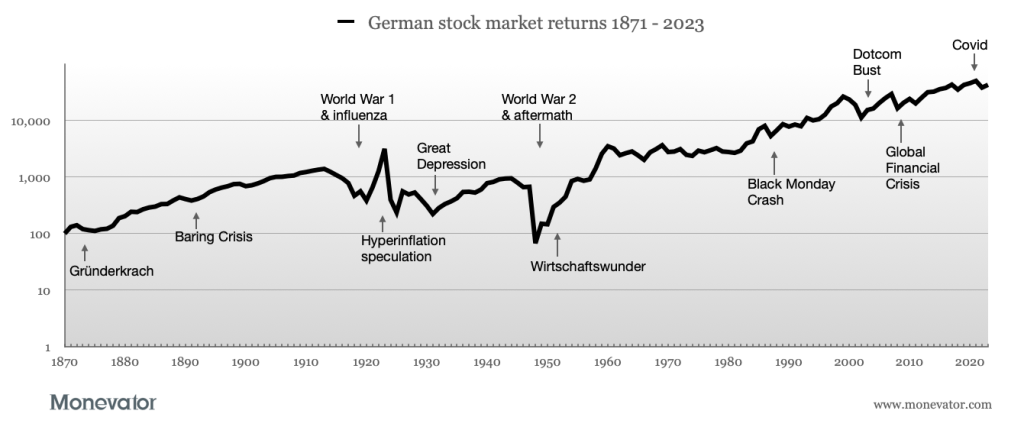How do you choose the best bond funds or bond ETFs from the bewildering array of products available?
Many investors find bonds deeply unintuitive – and the asset class’s inflation-fuelled crash in 2022 hasn’t exactly inspired them to dig deeper.
Yet a solid allocation to high-quality government bonds remains the first stop when it comes to strategically diversifying a portfolio dominated by equities.
And that remains true even after last year’s once-in-a-generation carnage, when those hoped-for diversification benefits truly failed to show up.
Interest-ing bonds
It seems like a good time to take a deep breath and a step back.
We’ve previously explained the purpose of bonds within a passive investing portfolio.
For UK investors, it boils down to investing in UK government bonds (known as gilts) and/or the government bonds of other developed markets. Such bonds are the likeliest to cushion your equities when stock markets plunge. And that’s just what we want our bonds for. (Equities can deliver the long-term returns – provided we hold on to them…)
We believe the best bond fund vehicles are ETFs and index funds. That’s because their low fees leave more return in the pockets of investors – as opposed to fat-cat fund managers. (See below for more on the ‘ongoing charge figure’, or OCF).
We’ll explain our choices below, but first let’s run through our picks for the best bond ETFs and bond index funds. We’ll do gilts first, and then global government bonds further below.
Best bond funds and ETFs – UK gilts
Fund/ETFCost = OCF (%)IndexDurationYTM (%)Credit qualityDomicileLyxor Core UK Government Bond ETF0.07FTSE Actuaries UK Conventional Gilts All Stocks8.44.7AALuxiShares Core UK Gilts ETF0.07FTSE Actuaries UK Conventional Gilts All Stocks8.44.6AAIrelandiShares UK Gilts All Stocks Index Fund0.11FTSE Actuaries UK Conventional Gilts All Stocks8.74.6AAUKVanguard UK Gilt ETF0.07Bloomberg Sterling Gilt19.94.5AAIrelandVanguard UK Government Bond Index Fund0.12Bloomberg UK Government29.94.5AAIrelandInvesco UK Gilts ETF B0.06Bloomberg Sterling Gilt94.6AAIreland
Source: Fund providers’ data / Morningstar (A dash means data not provided).
YTM is yield-to-maturity. ‘Lux’ is Luxembourg.
These are intermediate gilt ETFs and funds because, for most investors, intermediates offer a better balance of risk versus reward than long bonds (far riskier) or short bonds (a miserly reward).
Dedicated long or short bond allocations will be right for some people, though.
We’ve previously explained your broader options and delved into how they behave.
You can find more product suggestions in our low-cost index funds and ETFs guide.
There is little to separate the funds in the table. That is just as it should be! Competition between index tracker providers is fierce, so most advantages have by now been eroded away.
You can be confident you’re in the right ballpark so long as you choose a cheap bond ETF or bond fund, with a good track record among its peers.
More on that below. But first a couple of notes about the bond features picked out in the table.
Ongoing Charge Figure (OCF)
The OCF is the annual cost of the product charged to you by the fund provider, as a percentage of your holding. So if you own £10,000 worth of a fund then a 0.1% OCF means you’ll pay around £10 in fees.
Lower charges are always better. Costs matter.
Duration
Average duration is an approximate guide to how much a bond fund will gain or lose in response to a 1% change in market interest rates.
For example:
A bond fund with a duration of 10% will lose around 10% of its market value for every 1% rise in its interest rate.
The fund’s price will similarly jump about 10% if its rate drops by 1%.
The higher a bond’s duration, the greater the capital gain or loss as its market interest rate fluctuates.
The market interest rate of a bond is not the base rate set by the Bank Of England. The market interest rate is a product of supply and demand for each individual bond on the bond market. If the Bank Base Rate is hiked by 1%, that doesn’t mean every bond will follow suit.
Yield-to-maturity (YTM)
The expected annual return of your bond fund is its current yield-to-maturity.
This number will fluctuate as bond prices move. But the main takeaway is that there’s nothing between these products. (Note that when we refer to yield in this article, we’re talking about YTM).
Credit quality
This is a guesstimate of the financial strength of the bond issuer. (That’s the UK Government in the case of the gilt funds in the table above.)
AAA is top-notch while BBB- sets the floor for investment grade. Below that is ‘junk’.
The higher the credit quality rating, the better. It means there’s less chance the issuer will default on payments, at least according to the bond rating agencies.
Bond rating systems and verdicts vary slightly by agency but our main message would be to stick to investment grade.
In other words, don’t touch someone else’s junk.
Bond fund credit quality is the weighted average of all its bonds ratings.
Domicile
Location matters because funds based in the UK benefit from FSCS investment protection. With that you could be eligible for compensation should your investment provider go bankrupt.
True, it’s highly unlikely that you’ll ever need to worry about this provision, especially given the scale of the giant fund shops in our table. But it’s a wrinkle worth knowing about.
Moving on, how have our best bond funds performed this past decade?
Best bond funds and ETFs – UK gilts results check
Source: Trustnet multi-charting tool
We’ve expanded our product scope for this performance check. Partly because doing so illustrates some useful points about bond funds, and partly to again show there’s little to choose between good index trackers.
We’ve highlighted the candidates’ 10-year annualised returns (nominal) within the green box because the longer the timeframe, the more meaningful our comparison.
The cyan lines underscore the main indexes tracked by the best bond funds.
With friends like these…
One thing leaps out immediately from our performance check: bond returns over the period have been absolutely terrible.
A near-zero return over ten years – and stiff losses over tighter time periods – does make you wonder why you’d bother with bonds.
The fact is that unfortunately the entire asset class was smashed in 2022 as interest rates surged and rising bond yields inflicted heavy capital losses.
But counterintuitively, the prospects for bonds are much brighter now that yields are higher (and prices lower).
The reason for this is that bond yields are predictive of future expected returns. If inflation subsides to its historic norm (around 3%) then the yields quoted above would deliver a bond return slightly ahead of its long-term average of 1.4% (real, inflation-adjusted return).
In other words, bonds are now priced to deliver a reasonable return for a defensive asset, even as they also fulfil their primary role as a stock market diversifier.
How things change
When we first wrote this article in May 2021, bonds had delivered excellent 10-year returns but their low yields warned of trouble ahead.
The table below is a nice demonstration of how low yields can correlate with excellent backward-looking returns but auger grim returns in the future.
This representative fund had a terrible yield in May 2021. But its returns over the previous 10-years had been superb:
Vanguard UK Gov Bond FundYield (%)10yr return (%)May 20210.94.8Sep 20234.50
Fast-forward to September 2023 and you can see the situation has completely reversed. The yield is healthy again but the 10-year returns are awful (because rising yields cause bond prices to fall).
September 2023’s 0% return over ten years is the fulfilment of May 2021’s low yield prophecy.
Boiled down, yield is the best guide we have to an intermediate bond fund’s expected return over the next decade.
No guarantees, but the asset class’s potential has largely been restored by the bond market dumping that’s burned investors – even as it causes so many to now avoid bonds like sewage on a UK beach.
Here for the duration
Back to our results check. You might look at the table and think the Vanguard UK Government Bond Index fund is the last place you want to be. After all, it’s earned nothing for a decade. And it looks worse than the rest of the field across the other timeframes, too.
Yet the same fund’s 10-year returns were ahead of the pack just two years ago! It’s table-topping performance then – and relegation form now – is mostly due to the longer duration of its holdings.
A higher duration juices your holdings when bond prices rise (and yields fall) but acts as a ball-and-chain when prices fall (and yields rise).
In other words, there’s nothing inherently wrong with either of these Vanguard bond trackers. If prices rise from here then they’ll leapfrog back up the rankings.
That makes the Vanguard pair the best bond fund choice in our table for recession protection, incidentally.
But opt for a shorter duration fund if you think interest rates can only go up or inflation continue to rise – or if you want to dial down the volatility in your bond allocation, even at the cost of some potential gains.
How to compare best bond fund and ETF results
The duration issue helps illustrate why choosing your bond fund isn’t as simple as picking the one that has scored a few extra drops of return at a particular moment in time.
A fraction of a percentage point makes little odds, and it doesn’t tell us which tracker will nose ahead next year or next decade.
Here’s what I’m looking for when I look at the performance table:
Firstly, are any of our comparable bond funds doing something highly unusual? If one product is way ahead of the rest – or completely off the pace – then perhaps it’s not what we think it is. Deviant behaviour is a cue for further research.
In this instance, the trackers are all relatively evenly matched across five and ten years, once you factor in duration differences.
I completely ignore one-year and three-year time periods if I’ve got better data. I never compare funds over one-year anyway. That’s too short to tell you anything meaningful. Longer is better.
Now turning to the indices…
Are our potential best bond funds a good match for their respective index over time? (I’ve underlined the 10-year index return rows in cyan). You’d expect an index tracker to slightly lag its index, after costs.
If a bond tracker is a smidge ahead of, or behind, its index then no matter. But if it lags then strike it off your short list – begone HSBC UK Gilt Index!
You have reason to suspect one index is inferior to another? Then you can sweep its adherents off the table too.
Most intermediate gilt funds follow the FTSE Actuaries UK Conventional Gilts All Stocks index. The Invesco and SPDR Gilt ETFs moon after the Bloomberg Sterling Gilts Index, while Vanguard’s twosome chase Bloomberg’s float adjusted benchmarks.
Here again, the 10-year returns show that the indices are close competitors – with the ‘float adjusted’ index’s shortfall explained by its longer duration holdings.
Where does this leave us?
The sweet spot is getting the blend of features you want from your bond fund at a low cost. It’s only worth factoring in the returns snapshot if one tracker looks consistently superior to the rest.
There’s no point being derailed by minuscule performance differentials if you want a UK-domiciled fund that is available on zero-commission dealing with your broker.
If you’re specifically after a bond ETF (rather than a mutual fund) then the Lyxor gilt tracker is dirt cheap and has edged its index over 10 years. It was second only to the Vanguard UK Government Bond Index fund in 2021, too, despite its shorter duration.
The Invesco ETF is a touch cheaper but it doesn’t have a long-term track record yet.
The 10-year returns of the SPDR Gilt ETF look fine, but it’s twice as expensive as its cheaper rivals. I’d knock it out on that basis because high costs are a proven drag factor.
Finally, the Vanguard trackers are the way to go if you want their extra duration.
Best bond funds and ETFs – Global government bond (GBP hedged)
Fund/ETFCost = OCF (%)IndexDurationYTM (%)Credit qualityDomicileiShares Global Government Bond ETF 0.25FTSE G7 Government Bond Index7.43.7AAIrelandXtrackers Global Government Bond ETF 2D0.25FTSE World Government Bond Index – Developed Markets7.53.5AALuxAmundi Index JP Morgan GBI Global Govies ETF0.15JP Morgan GBI Global Index6.93.5A+LuxAbrdn Global Government Bond Tracker Fund B Acc0.14JP Morgan GBI Global Index72.2AAUKiShares Overseas Government Bond Index Fund (UK)0.13JP Morgan Global Govern Bond Index ex-UK6.93.4–UKUBS JP Morgan Global Government ESG Liquid Bond ETF0.2JP Morgan Global Government ESG Liquid Bond Index–––Lux
Source: Fund providers’ data / Morningstar (A dash means data not provided).
YTM is yield-to-maturity. ‘Lux’ is Luxembourg.
The choice of global government bond funds and ETFs has exploded since we last looked in 2021. Costs have been slashed by new entrants and there’s even an ESG contender from UBS.
The downside is that only the two older iShares and Xtrackers products have a long-term track record – which is why they crest the table. The Amundi and Abrdn index trackers will notch up three year records shortly, whereas the iShares Overseas fund only launched in August 2023.
Meanwhile, the UBS ESG effort is consigned to the bottom because the Swiss bank hasn’t yet published some very basic information. (Note the blanks in our table.)
Something also seems off about the very low yield published by Abrdn, but that’s the figure it has given. I think I’d rather take a higher yield from one of the other funds, considering they’re not exposing me to much (if any) more risk.
(Incidentally, I’ve had to edit the product names to fit the the table so make sure your choice is badged GBP hedged when you select it from your broker. Some of these funds have unhedged variants but the right product will always have GBP hedged in its name.)
Now let’s do a results check before talking about why you might plump for global government bonds over gilts.
Global government bond (GBP hedged) results check
Source: Trustnet multi-charting tool
Remember, the main objective in comparing results is just to make sure there isn’t a weird outlier on the shortlist. We also want to see if any fund is consistently dragged down by hidden costs.
But the truth is we don’t have much to go on anyway because most of the products are quite new.
What we do know is that intermediate global government bond funds are typically shorter duration than their UK counterparts. That helps explain why they haven’t suffered as much as gilt funds in the sell-off.
Well, that and the fact that interest rate rises have been sharper in the UK.
Global government bonds versus gilts
Diversifying across global government bonds came into vogue in the aftermath of the Great Recession as many countries lost their cherished AAA credit ratings – the UK among them.
As government debt balloons, many investors prefer not to rely on the full faith and credit of their home country.
Strangely, so-called global government bond funds usually hold developed market sovereign debt only.
But that’s actually a good thing because the role of your bond allocation is to lower your overall portfolio risk. So steer clear of global funds that hold much more volatile emerging market bonds.3
What about the underlying indexes? It’s hard to get good information, but factsheets are out there.
As global bond funds are about spreading your bets, it’s worth knowing that the FTSE World Government Bond Index (Developed Markets) is the most diversified by country, followed by the JP Morgan GBI Global Index, and finally the FTSE G7 Index.
On that front, you might ask why would you ever go for a 100% gilts fund4, given the diversification benefits of global government bonds?
Well, you might because the gilt trackers are less costly to own, have a higher yield, and may offer marginally more crash protection to UK investors.
But ultimately that’ll all be cold comfort if the UK state’s finances do eventually go pop. Granted, that’s a nightmare scenario. But it’s also one that once seemed far less plausible than in recent times.
Don’t take currency risk
If you opt for global bonds then make sure you pick a fund that hedges its return to the pound. Doing so removes currency risk from the defensive side of your portfolio, if you’re a UK-based investor.
While currency risk may sometimes be viewed as a positive and diversifying factor for equities, the same is not true for government bonds.
Currency exchange rate fluctuations add volatility to your returns. Government bonds are there to lower it.
Some investors leave their global bonds unhedged. But betting on exchange rates is an advanced move. It’s only justifiable if you really know what you’re doing.
We’ve looked at the mixed bag of evidence for this ploy before in a US Treasuries vs Gilts post.
Don’t sweat the small stuff
From a big picture perspective, any of the index trackers gracing our tables of best bond funds (and bond ETFs) tick the right boxes.
I’ve touched on a few key details to consider. But even those differences will likely prove marginal across many years of passive investing.
The most important investing decision is diversifying between equities and government bonds in the first place.
Choose a competitive bond index fund or ETF as the main brace of your defensive asset allocation and you’ll be on the right course.
Further reading:
To help you read a bond fund webpage
Decode tricky bond terms lingo
For best global tracker fund suggestions
Take it steady,
The Accumulator
Note: Earlier comments below may refer to our 2021 take on the best bond funds. We’ve left them standing for reader interest, but please do check the dates before replying!
Float AdjustedFloat AdjustedYou might want a dollop of emerging market bonds for other reasons. If so, we suggest you draw from your equity allocation.That is, a UK-only fund.
The post Best bond funds and bond ETFs appeared first on Monevator.



